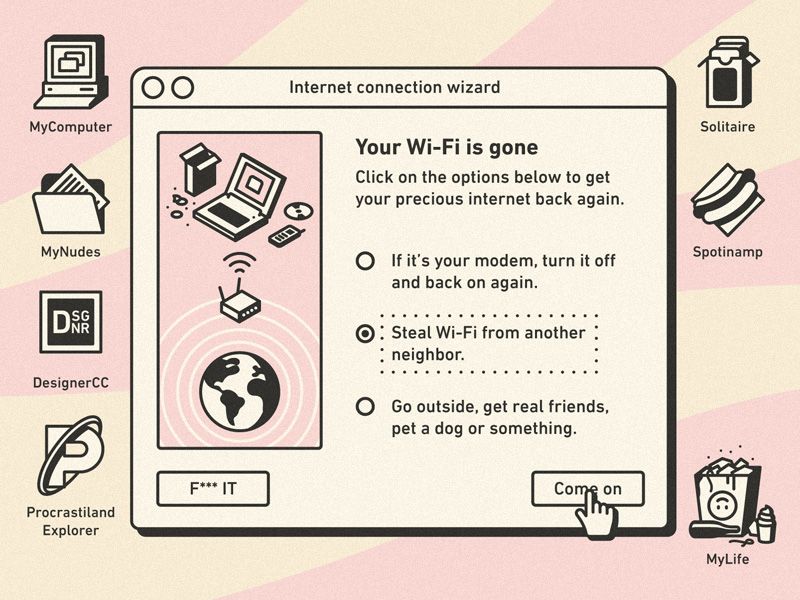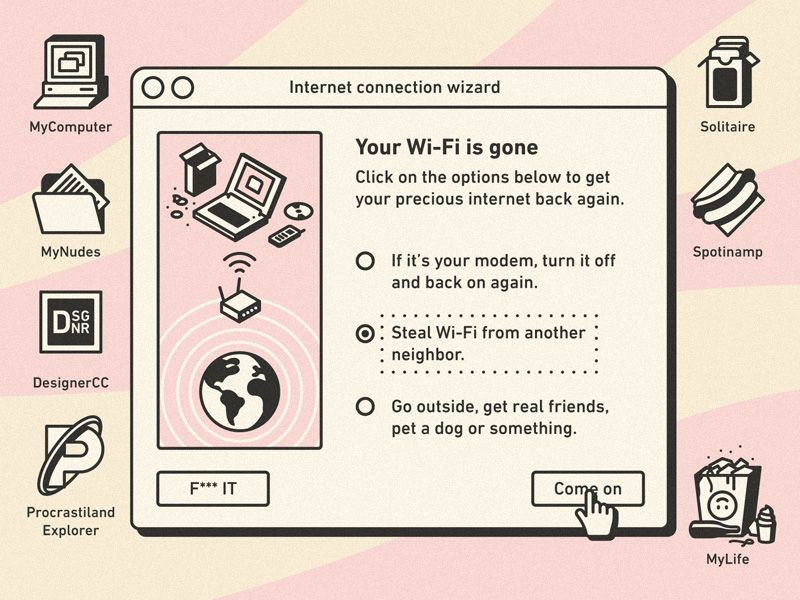A Short History Of Internet Access & Internet Service Providers (ISP's)
Many of us remember the days before the internet, even if it now seems like a distant and forgotten dream. Learn about the history of the internet and the ISP market in this short history.

I am not by any measure old but I remember when we had no internet and my nieces minds boggle at that, they think I must be ancient. How could you survive without internet they ask and in their minds the concept is pretty much science fiction, the mere thought of not having internet filled them with dread.
I have been hooked on computers ever since the ZX Spectrum was first released, back then you had to manually code all of your applications in BASIC if you actually wanted your computer to do something useful. The only real alternative to typing hundreds of lines of code was to load a cassette tape into your computer.
Those cassette tapes contained pre-recorded sounds which told your computer what to do and that was what what the internet sounded like the first time I heard it. No that wasn't a typo, I heard the internet before I ever actually saw it and I sort of believe that cable internet is fake internet because it is so eerily silent all of the time.
I didn't hear the internet because I am an internet whisperer, we ALL heard the internet before we ever actually used it back then, its how we knew the internet was coming, its arrival heralded by a series of high pitched screeches and digital burbles that came to you from down the phone line which sounds like this.
In the old days we didn’t really have internet service providers (ISP’s), we just called each other up over the phone and had our computers burble and screech at each other, this was called a handshake and as crazy as it sounds, it was how you connected your computer to ‘the internet’ back in those days.
The problem was that you needed to be technically minded enough to know how to do that in an age when convenient techie friends who could explain it to you were not a thing yet. For a while, geeks were the only people on the internet, then geeks, spooks, the military and universities were the only people on the early internet.
The early internet was very crude, it was mostly individual machines talking to each other over the phone lines at first, initially the phone companies did not even know this kind of early internet traffic was passing over their telephone networks.
Before ISP’s you had to have an account at a university or government agency to connect to the internet. When 'the internet' began accepting commercial traffic in the early 1990’s there was an agreement with commercial internet users that they had to honor the peering protocol of swapping data free of charge. This meant that if they wanted their traffic to pass over your ‘bits of the internet’, they had to accept your traffic over their own bit of the internet, the basis of modern net neutrality.
In 1994 the National Science Foundation took the internet into its own hands and commissioned four private companies to build public access points, strategically positioned in San Francisco, Washington DC, Chicago and New Jersey they came under the direct control of WorldCom, Pacific Bell, Sprint and Ameritech who became Americas first real internet service providers (ISP’s).
As internet traffic increased over time, those public access points became congested with traffic and the major telco’s around at the time began building out their own internet backbone, composed of faster private access points. Initially the larger and more dominant backbone providers honoured the peering protocol and worked out peering agreements with smaller ISP’s, meaning they would all exchange each others internet traffic for free. This changed of course, when in 1997 UUNET, Sprint and AT&T broke the peering agreement and started charging smaller ISPs to gain access to their networks, the beginning of the very first net neutrality battles.
In those early days of the ISP industry, there were hundreds of commercial internet service providers in the United States and according to PC Magazine the average monthly connection fee for each account was roughly $17.50, with an additional charge of $3-4 an hour for the time that you were connected. Back then this was expensive and connecting to the internet for long periods of time could quickly run up your phone bill., something that was really easy to do if you spent time online.
There wasn’t much fun to be had on the internet back then, it was mostly still just geeks, businesses, universities and the government using it, so for a lot of people it still didn’t make any sense to go onto the internet, especially as you still had to connect using a command line, or a proprietary graphical user interface provided by your ISP. The internet browser along with HTML to build web pages had not quite been invented yet at this stage and IBM/Microsoft were still in the process of building internet technology into their operating systems and hardware.
An Early History of the ISP Industry
Things rapidly progressed of course, and throughout 1995 the ISP market in the US heated up and quickly became very competitive. At that time the dominant ISP’s were Netcom and UUNET with annual revenues of around $40-50 million to give you an idea of the market size back then. While Netcom was busy pioneering the worlds first flat rate internet pricing for the US consumer market, Netcom were busy signing up business and corporate customers. It wasn’t just these two who were beavering away building the early internet, you also had large interexchange carriers (telco providers) like AT&T and MCI and thousands of regional ISP’s.
The early ISP market was very fragmented, it contained lots of different kinds go companies all innovating and developing the early internet in different ways to serve the different requirements of its users. Business and consumer internet users wanted two completely different things back then, consumers wanted low cost access above all else, they were sick of paying a small fortune every month to use the internet, but businesses were much more focused on reliability and speed.
Boom & Bust
The number of internet service providers increased from about 1400 in early 1996, to around 3000 ISP’s in 1997, a literal explosion of competition in the market and by 1998 there were an estimated 4500 ISP’s in North America (USA & Canada). A lot of them were small mom and pop operations that served local consumers and small business in local markets, these guys survived back then by leasing and then reselling the internet services of much larger internet service providers.
As the market began to consolidate towards the end of the 90’s, these small operators began merging with telephone companies in order to stay in business and provide their customers with a single source for internet and phone connections.
Then you had much bigger ISP’s who grew through acquisition, one of the biggest was Earthlink with around 320,000 customers and they rapidly grew by buying smaller ISP’s and merging them into what they called the Earthlink Network, which allowed the smaller ISP’s keep their brands and identities in their own markets.
Earthlink handled all the billing and paid the ISP’s for their new customers, they also provided things like startup CD’s and marketing materials. Earthlink was really one large ISP, but it looked like a thousand smaller ones, with a thousand different names. It was a very different internet market in the late 90'2, there were thousands of ISP's and many went bust or got bought in a fiercely competitive climate.
Industry Consolidation
As with any rapidly emerging industry, the multiple players and the fragmented market gradually begins to consolidate. The telephone companies and the internet backbone providers all began to merge and be acquired, led by long distance telephone carrier Worldcom who bought UUNET's parent company MFS for $12 billion, creating the second largest internet backbone in the USA. Then the largest regional telephone provider in the US, GTE Corp (aka General Telephone & Electric Corporation) bought internet backbone provider BBN Corp for $616 million, a phenomenal sum of money in the late 90’s for any kind of acquisition.
E-Commerce Makes An Appearance
By the end of the 90’s, the e-commerce industry was rapidly growing and businesses were interested in working with ISPs who could provide audience and reach. The old peering protocol came back into fashion as ISP’s made peering arrangements with their competitors so that they could carry each others traffic and widen their respective internet backbone networks as their customers became much more focused on things like network access, reliability, performance and capacity.
The Raging Noughties
By the year 2000, the ISP market looked very different from just five years before, with Earthlink, PSInet, Mindspring and UUNET ranking as the top four national internet service providers for businesses. In the consumer market, a whole different set of ISPs were vying for dominance with Excite@Home, The Microsoft Network, Prodigy Communications and America Online (AOL) ranking in as the top four consumers ISP’s. Back then AOL was the largest player with around 20 million subscribers (thanks to their blitzing the entire country with startup CDs for a good decade), closely followed in second place by Earthlink with 4.7 million subscribers, with Microsoft and Prodigy in third and fourth place with 5 million and three million subscribers respectively. In early 2000 and for the first time anywhere on the planet, millions of internet users were regularly going online.
The ISP Wars
As the noughties got into full swing, the ISP Wars began with fierce competition between large and small ISP’s who were in turn being squeezed by the internet backbone providers, the people who actually owned the infrastructure upon which the internet ran. Although nobody really owned the internet, the infrastructure that ran the internet was owned by a small group of very large corporations and control of the internet infrastructure gave them the power to tax smaller ISPs for access to networks and to charge them for operating the network access points where the ISP’s traded traffic (packets) with each other. The bigger ISP’s like AOL were able to negotiate better deals than smaller players and the result was less competition in the market, with higher barriers to entry for new entrants. During this time we saw consolidations, mergers and bankruptcies as ISP’s battled it our for market share.
The end result of the ISP wars was less choice for consumers and business internet users, but even back then when the ISP market was dominated by big players, consumers and businesses could still choose from an estimated 7000 ISP’s in 2002.
There was still at this point plenty of market share to go around with consumers favoring smaller regional ISPs who were offering value added services like web design and e-commerce services in order to compete with larger ISPs who could guarantee wide reach and faster, stable, more reliable internet access.
Present Day
Today we would struggle to imagine a time when, depending on your region, you could choose from any one of potentially hundreds of ISP’s. In 2017 the consumer broandband market is an effective duopoly in some parts of the country, controlled by the two of largest ISP’s that own their own internet backbone, Comcast and AT&T. Consumer internet speeds are ridiculously low in those parts of the country, despite their users paying some of the highest internet access fees in the country.
AT&T’s merger with Time Warner in 2016 only consolidated the already massive hold they had on the US internet market and was one of a string of deals that further placed control of the internet into fewer corporate hands. In 2015 Comcast had to abandon its $45 billion dollar bid for Time Warner after the FCC opposed the merger because of the fear that it would create an ISP with ’too much control’ over what Americans do and watch online. This did not remain a fear for long.
In 2016 the FCC approved the merger of Charter Communications with Time Warner to create the second largest broadband provider in the US with seventy percent control of the high speed internet market and just a short time later the FCC green lighted the AT&T and Time Warner merger for a whopping $85 billion dollars. Finally let's not forget about Verizon buying AOL for $4 billion dollars, or Verizon buying Vodafones chunk of Verizon Wireless for a whopping $130 billion to create the largest wireless internet provider in the US.
What Does This Mean For You ?
In a nutshell it means higher prices and fewer choices for end users, as businesses and consumers struggle to negotiate better rates with ISP’s who control huge swathes of the US internet market. This means that depending on where you are based (even within a state) your internet bills could vary by as much as 50%. For example two thirds of Los Angeles residents living in areas served by sometimes just one internet service provider. Weak competition yields high prices and places little pressure on ISPs to upgrade networks in order to offer faster internet service.
In LA County for example, fibre based services (faster internet than DSL or cable) are available in less than a quarter of the census blocks, but overseas in foreign cities (like Paris for example) internet users have a choice of at least six providers with coverage approaching 100% for fast fiber optic internet connections.
If you are a business or consumer internet user trapped in one of these no competition areas you are out of luck, at least until Google Fiber decides it wants to move to your city, which it probably isn’t just yet. You are literally being held to ransom and forced to pay higher bills for lower quality internet service.
This puts American internet users, business or consumer, at a significant disadvantage to their foreign competitors over the long term. Internet access is something we have become completely dependent on in modern life and access to it is greedily milked by the organizations who currently control it and who show little interest in investing in the underlying infrastructure for the good of the network.
This is the sad end to our short history of internet access, especially when you consider that the internet was first born in the US. Remember kids, competition is healthy and this is especially true when it comes to the internet.


